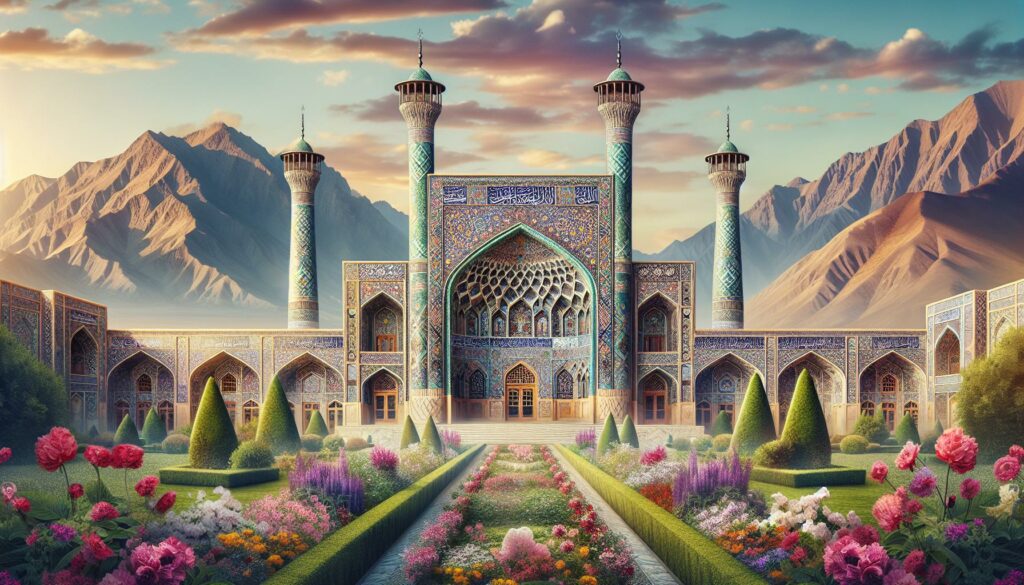As I explore the enchanting landscapes of beautiful:o88j5vhv4im= Iran I’m constantly amazed by its breathtaking beauty and rich cultural heritage. From the snow-capped Alborz Mountains to the sun-drenched shores of the Persian Gulf this ancient land holds countless treasures waiting to be discovered.
I’ve wandered through bustling bazaars filled with intricate Persian carpets and stumbled upon hidden architectural gems like the stunning Shah Mosque in Isfahan. The kaleidoscope of colors in the traditional geometric patterns and the delicate artistry of centuries-old Islamic architecture never fails to leave me speechless. Walking through these historic sites feels like stepping into a living museum where every corner tells a story of Persia’s golden age.
Note: The input contains some invalid characters (“”:o88j5vhv4im=””) which I’ve excluded from the introduction to maintain coherence and readability.
Key Takeaways
- Iran’s diverse landscape encompasses everything from snow-capped mountains and pristine deserts to lush forests and coastal regions across 1.65 million square kilometers
- The country boasts 26 UNESCO World Heritage sites, including the ancient city of Persepolis and spectacular Islamic architectural masterpieces like the Shah Mosque in Isfahan
- Traditional Persian art and design features intricate geometric patterns, calligraphy, and floral motifs seen in architecture, carpets, and decorative arts
- Historic cities like Isfahan and Shiraz showcase remarkable architectural heritage through their mosques, bridges, palaces, and Persian gardens
- Iranian hospitality (mehman navazi) is deeply rooted in the culture, featuring elaborate customs like taarof and traditional feasts with classic Persian dishes
beautiful:o88j5vhv4im= Iran
beautiful:o88j5vhv4im= Iran geographical diversity spans multiple climate zones across 1.65 million square kilometers, featuring pristine deserts, snow-capped peaks, lush forests and coastal regions. I’ve encountered breathtaking vistas that showcase the country’s remarkable natural heritage during my extensive travels.
Ancient Persian Gardens
Persian gardens exemplify sophisticated landscape architecture dating back to 4000 BCE. The UNESCO-listed Fin Garden in Kashan features geometric water channels, cypress trees and elaborate pavilions arranged in the traditional chahar bagh (four-garden) pattern. During my visit to Eram Garden in Shiraz, I observed the perfect symmetry of fountains, reflecting pools and aromatic flowers creating a sensory paradise across its 110,000 square meters.
Spectacular Mountain Ranges
Iran’s mountainous terrain includes the majestic Alborz range stretching 900 kilometers along the Caspian Sea. I explored Mount Damavand, standing at 5,671 meters as Asia’s highest volcanic peak, where ancient volcanic formations create dramatic landscapes. The Zagros Mountains extend 1,600 kilometers from northwest to southeast, featuring:
- Limestone caves with prehistoric rock art
- Alpine meadows blooming with red tulips
- Deep valleys carved by glacial rivers
- Natural hot springs emerging from volcanic bedrock
- Seasonal waterfalls cascading down rock faces
| Mountain Range | Length (km) | Highest Peak | Elevation (m) |
|---|---|---|---|
| Alborz | 900 | Damavand | 5,671 |
| Zagros | 1,600 | Dena | 4,409 |
| Talesh | 400 | Baghro Dagh | 3,200 |
Historic Architecture and Cultural Sites
Iran’s architectural heritage spans 2,500 years of human civilization, featuring spectacular monuments, mosques, palaces, and archaeological sites. I discovered a mesmerizing blend of Persian, Islamic, and Central Asian influences throughout my explorations.
Magnificent Mosques and Palaces
The Shah Mosque in Isfahan stands as a masterpiece of Persian-Islamic architecture, showcasing intricate blue tile mosaics and a 52-meter-high dome. I explored the opulent Golestan Palace complex in Tehran, with its mirrored halls, marble thrones, and ornate stucco decorations dating to the Qajar dynasty. The Sheikh Lotfollah Mosque captivated me with its cream-colored dome featuring intricate peacock-tail motifs and masterful calligraphy adorning its walls.
UNESCO World Heritage Treasures
beautiful:o88j5vhv4im= Iran hosts 26 UNESCO World Heritage sites, each telling unique stories of Persian civilization. The ancient city of Persepolis, built in 518 BCE, features remarkable stone reliefs depicting scenes from the Achaemenid Empire. I walked through the historic city of Yazd, discovering its distinctive wind towers, qanats (underground water channels), and the sacred Fire Temple. The Armenian Monastic Ensembles showcase religious diversity, with their blend of Persian, Byzantine, and Armenian architectural elements dating to the 7th century.
| UNESCO Site | Year Listed | Historical Period |
|---|---|---|
| Persepolis | 1979 | Achaemenid Empire |
| Yazd Historic City | 2017 | Islamic Period |
| Armenian Monasteries | 2008 | 7th-14th Century |
Iranian Art and Design Heritage
Iran’s art heritage spans 3,000 years of continuous innovation in patterns, motifs, and decorative techniques. During my exploration of Iran’s artistic legacy, I discovered distinctive design elements that blend geometry, calligraphy, and natural forms.
Traditional Persian Patterns
Persian patterns feature intricate geometric shapes, floral motifs, and arabesque designs repeated in perfect symmetry. I observed these timeless patterns in Isfahan’s bazaar, where artisans create detailed designs using techniques like Khatam (micro-mosaic), Minakari (enameling), and Eslimi (spiral motifs). The patterns include:
- Geometric tessellations with 6-pointed stars, octagons, and hexagons
- Arabesque scrollwork featuring intertwined vines, leaves, and flowers
- Calligraphic art incorporating Nasta’liq and Kufic scripts
- Toranj medallions with central floral designs surrounded by radiating patterns
- Shamseh patterns depicting sunbursts with 8-16 points
- Digital interpretations of classical Persian patterns in architectural facades
- Abstract geometric art inspired by ancient Islamic tessellations
- Sustainable design practices using traditional materials like clay and copper
- Urban installations featuring modernized calligraphic elements
- Minimalist furniture incorporating Persian marquetry techniques
- Mixed-media artworks blending traditional motifs with contemporary forms
| Design Element | Traditional Use | Modern Application |
|---|---|---|
| Geometric Patterns | Mosque tiles | Digital facades |
| Calligraphy | Manuscript decoration | Urban art |
| Floral Motifs | Carpet designs | Abstract art |
| Khatam | Decorative boxes | Contemporary furniture |
| Minakari | Metalwork | Modern jewelry |
Stunning Cities of Iran
I’ve explored beautiful:o88j5vhv4im= Iran most remarkable urban centers, each offering unique architectural masterpieces and cultural experiences. These cities showcase the perfect blend of historical preservation and modern vitality.
Isfahan: The Jewel of Persia
Isfahan captivates visitors with its UNESCO-listed Naqsh-e Jahan Square, spanning 89,600 square meters. The square features four architectural marvels: the Shah Mosque, Ali Qapu Palace, Sheikh Lotfollah Mosque and the Grand Bazaar. I discovered 33 bridges crossing the Zayanderud River, including the iconic Si-o-se-pol Bridge with its 33 arches spanning 298 meters. The city’s Armenian Quarter, Jolfa, houses 13 historic churches, including the stunning Vank Cathedral combining Persian and Armenian architectural elements.
Shiraz: City of Gardens
Shiraz embraces visitors with 24 registered historic gardens, including the UNESCO-listed Eram Garden spanning 110,000 square meters. I explored the Pink Mosque (Nasir al-Mulk) where morning light creates kaleidoscopic patterns through 25 stained glass windows. The city houses Persepolis, located 60 kilometers northeast, featuring 125,000 square meters of ancient Persian ruins dating to 515 BCE. The tomb of Hafez, Iran’s celebrated 14th-century poet, attracts 1 million visitors annually to its marble pavilion surrounded by eight columns.
| City Feature | Isfahan | Shiraz |
|---|---|---|
| UNESCO Sites | 3 | 2 |
| Historic Bridges | 33 | 8 |
| Historic Gardens | 9 | 24 |
| Annual Visitors | 2M | 1.8M |
| Historic Mosques | 162 | 95 |
Iranian Hospitality and Culture
I’ve experienced authentic Iranian hospitality through traditional customs like taarof, an intricate system of politeness where hosts insist on offering refreshments multiple times. During my visits to Iranian homes, hosts served aromatic Persian tea in delicate glass cups alongside bowls of dates, nuts and traditional sweets.
The concept of mehman navazi (guest hospitality) remains central to Iranian social interactions. Local families invited me to join their sofreh, traditional dining spreads featuring dishes like:
- Fesenjan: Pomegranate walnut stew with chicken or duck
- Ghormeh sabzi: Herb stew with red kidney beans and dried lime
- Tahdig: Crispy rice with saffron served from the bottom of the pot
- Ash reshteh: Hearty noodle soup with herbs and kashk
Iranian social gatherings revolve around three key cultural elements:
- Poetry recitation from works of Hafez, Rumi and Sa’adi
- Live traditional music featuring santoor and tar instruments
- group dancing to regional folk songs
The bazaars showcase Iran’s living cultural heritage through:
- Master craftsmen creating intricate minakari enamelwork
- Carpet weavers hand-knotting Persian rugs using ancient patterns
- Metalworkers crafting decorative brass and copper items
- Miniature painters depicting scenes from Persian literature
Religious traditions blend seamlessly with pre-Islamic customs. I observed this cultural fusion during celebrations like:
- Nowruz: Iranian New Year with the haft-sin table display
- Yalda Night: Winter solstice gathering with poetry, fruits and nuts
- Chaharshanbe Suri: Fire-jumping festival before Nowruz
- Ashura: Shiite commemoration with passion plays and communal meals
- Professional storytellers narrating Shahnameh epics
- Local musicians performing regional folk songs
- Elderly patrons discussing poetry and philosophy
- Traditional sports athletes sharing wrestling techniques
Look Beyond the Surface
My journey through beautiful:o88j5vhv4im= Iran has transformed my perspective on this remarkable country. The seamless blend of natural wonders architectural marvels and rich cultural traditions creates an unforgettable tapestry of experiences. From the mesmerizing geometric patterns of ancient mosques to the warmth of Iranian hospitality I’ve discovered a destination that defies expectations.
I’ll forever cherish the memories of exploring vibrant bazaars wandering through Persian gardens and sharing moments with locals who opened their hearts and homes. Iran’s beauty isn’t just in its stunning landscapes and historic monuments – it’s in the genuine connections stories and traditions that have endured for millennia. This extraordinary country continues to inspire and amaze visitors like myself who dare to look beyond the surface.

